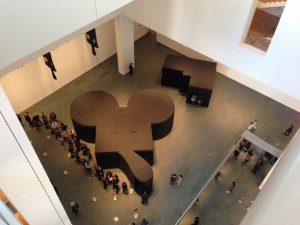 Claus Oldenburg’s Mouse Museum, now recreated at the Museum of Modern Art in New York, was hugely influential when I saw it at the Museum of Contemporary Art in Chicago in 1978. His collection of commercial tchotchkes (salt-and-pepper shakers, Plasticville train set buildings, robot toys, product packaging), shown with pieces of his own art and models for works in progress, validated my own nascent fascination with pop culture objects, proving that they were interesting in and of themselves. I was just starting to collect kitsch items, commercial paraphernalia, handicrafts — prosaic stuff that seemed to resonate with some kind of meaning, wit or design choice. Much of the resonance was in my head rather than in the objects. But Oldenburg’s own collecting made me believe it wasn’t a waste of time, though our underlying purposes were probably very different. Although I doubt I saw these Oldenburg quotes at the time, they reflect the longer-term direction my own interests took in the years after seeing the Mouse Museum: “The city is a landscape worth enjoying — damn necessary if you live in the city,” and “Dirt has depth and beauty.” Starting with serious buildings, evolving through roadside architecture,and eventually encompassing commercial shop signs, I made a conscious choice to observe and appreciate the built landscape exactly because it made living amidst it so much more tolerable, even interesting.
Claus Oldenburg’s Mouse Museum, now recreated at the Museum of Modern Art in New York, was hugely influential when I saw it at the Museum of Contemporary Art in Chicago in 1978. His collection of commercial tchotchkes (salt-and-pepper shakers, Plasticville train set buildings, robot toys, product packaging), shown with pieces of his own art and models for works in progress, validated my own nascent fascination with pop culture objects, proving that they were interesting in and of themselves. I was just starting to collect kitsch items, commercial paraphernalia, handicrafts — prosaic stuff that seemed to resonate with some kind of meaning, wit or design choice. Much of the resonance was in my head rather than in the objects. But Oldenburg’s own collecting made me believe it wasn’t a waste of time, though our underlying purposes were probably very different. Although I doubt I saw these Oldenburg quotes at the time, they reflect the longer-term direction my own interests took in the years after seeing the Mouse Museum: “The city is a landscape worth enjoying — damn necessary if you live in the city,” and “Dirt has depth and beauty.” Starting with serious buildings, evolving through roadside architecture,and eventually encompassing commercial shop signs, I made a conscious choice to observe and appreciate the built landscape exactly because it made living amidst it so much more tolerable, even interesting.
I also visited Inventing Abstraction at MOMA, though the Mouse Museum was my main destination. My fuse is longer than some, and I planned to walk through the show and enjoy some objects without fretting. But the show’s studied isolation of the work and the artists was stunning. Even if the offending title were mitigated by calling it “Abstraction Re-Invented” or “A New Abstraction” or “Inventing Modern Abstraction,” it would not remedy the curation’s reductionism.
I haven’t read the catalog so maybe it mounts a defense, but whatever justification could be applied, the isolation does a disservice to all, the modernist artists included. How can you appreciate the distinctiveness of their creativity if you don’t see it in context with the abstraction that came before? The falseness is even more aggravated by the absence of centuries worth of fabulous abstract art. History and fairness aside, including other threads of abstraction, including European, would have made the show a far richer and meaningful experience.
